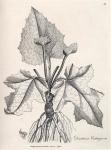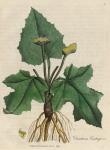
 Synonyma. Contrayerva. Pharm. Lond. & Edinb.
Dorstenia sphondylii folio, dentariae radice. Plum. ic. p. 109. tab. 119. Jacquin coll. vol. iii. Auctorum sequentium synonyma ad nostram plantam satis clare referri nequeunt.
Synonyma. Contrayerva. Pharm. Lond. & Edinb.
Dorstenia sphondylii folio, dentariae radice. Plum. ic. p. 109. tab. 119. Jacquin coll. vol. iii. Auctorum sequentium synonyma ad nostram plantam satis clare referri nequeunt.
Drakena radix. Clus. Exot. p. 83. J. Bauh. Hist. vol. ii. p. 740. Gerard. Emac. p. 1621. Raii Hist. p. 1339.
Contrayerva Hispanorum sive Drakena radix. Park. Theat. p. 421. Pro matre radicis contrayerva in medicina vulgo usitatae, ex vivis speciminibus cl. Houstoun duas dorsteniae species descripit, 1°
Dorstenia Dentariae radice, sphondylii folio, placenta ovali, 2°
Dorstenia Dentariae radice, folio minus laciniato, placenta quadrangulari et undulata. (Phil. Trans. vol. 37. p. 196 & 197)
Vel Dorstenia Drakena, et D. Houstoni. Lin. Syst. Veg.
Class Tetrandria. Ord. Monogynia. Lin. Gen. Plant. 158.
Ess. Gen. Ch. Receptac. commune 1-phyllum, carnosum, in quo semina nidulantur.
Spec. Char. D. scapis radicatis, fol. pinnatifido-palmatis serratis, receptaculis quadrangulis.
The root is perennial, tapering, unequal, compact, rugose, externally brown, internally whitish, and furnished with numerous fibres: the leaves are various, of an irregular shape, lobed, serrated, or rather dentated, pointed, veined,and placed upon long radical footstalks, which are winged towards the leaves: the scapi, or flower-stems, are round, rough, simple, rise several inches in height, and each supports an irregular quadrangular receptacle, which contains the necessary parts of fructification: the flowers on examination were discovered to be distinctly male and female, immersed in the common receptacle, and occupying the whole of its disc; the former consisted but of two slender short filaments, with yellow antherae; [This plant cannot therefore be properly said to belong to the class tetrandria.] the latter of a roundish germen, supporting a simple style, terminated by an obtuse stigma: the capsule, when ripe, possesses an elastic power, by which the seed is thrown out with considerable force. [Vide Jacquin. l. c.]—It is a native of South America and some of the Weft India islands. [Jacquin found it growing on the island of Martinico. Vide l. c.]
This plant is extremely scarce in Europe: the annexed figure of it was taken from a plant now in the Royal garden at Kew, where it was lately introduced, and is, we believe, the first of this kind that ever grew in England. [We do not find any species of the Dorstenia mentioned in the Hort. Kew. lately published.] It does not sufficiently appear from what authority Linnaeus gives the Dorstenia Contrajerva. The London College has however adopted it in the list of the Mat. Med. and in compliance with this we have figured the plant; at the same time we must acknowledge, that, upon the faith of Dr. Houston, who examined the Contrayerva plants in their native soil, [The first species on the high ground near Old Vera Cruz; and the second on the high rocky ground about Campechy in the year 1730. Phil. Trans. vol. 37. p. 197.] we should otherwise have had no doubt in referring the officinal radix contrayerva to the species he has described, as has been done by Bergius [Mat. Med. p. 73.] and Murray. [App. Med. vol. 4. p. 572.] But as Houston has observed, that the roots of different species of Dorstenia are promiscuously gathered and exported for those of the Contrayerva; and as all the species bear a great resemblance to each other, we conceive the further discussion of this subject to be of no material consequence. Nich. Monardus [Vide Clusius Exot. p. 311.] almost two centuries ago, first makes mention of the plant called Contrayerva; and as this name is of Spanish origin, signifying an antidote to poison, it might apply to any other plant supposed to possess this power. We are told by Clusius, that he received from Sir Francis Drake some roots which were brought from Peru, where they were highly valued, and reported to counteract the effects of every kind of poison, of which the leaves of the same plant were said to be one. This root, in compliment to the circumnavigator, he named Drakena radix, and is generally thought by botanists to be that of Contrayerva. The generic name, Dorstenia, was first used by Plunder, [Nov. gen. plant.] and afterwards by Linnaeus, who makes four species of this genus.
The root of Contrayerva has a peculiar kind of aromatic smell, and a light astringent warm bitterish taste, and on being long chewed it discovers somewhat of a sweetish sharpness. According to Lewis, "Contrayerva root gives out its virtue, by the assistance of heat, both to water and rectified spirit, and tinges the former of a dark brownish red, the latter of a brighter reddish colour: the watery decoction is very mucilaginous, so as not to pass through a filter." [Lewis Mat. Med.]
The antipoisonous virtues formerly attributed to this root, have been long very justly exploded as entirely chimerical, so that it is now merely employed as a diaphoretic of a moderately stimulant kind, being possessed of less pungency than any other of those medicines usually denominated alexipharmic. Putrid and nervous fevers are the diseases in which Contrayerva is chiefly used, conformably to the practice of Huxham and Pringle, whose works are well known to all our medical readers.

